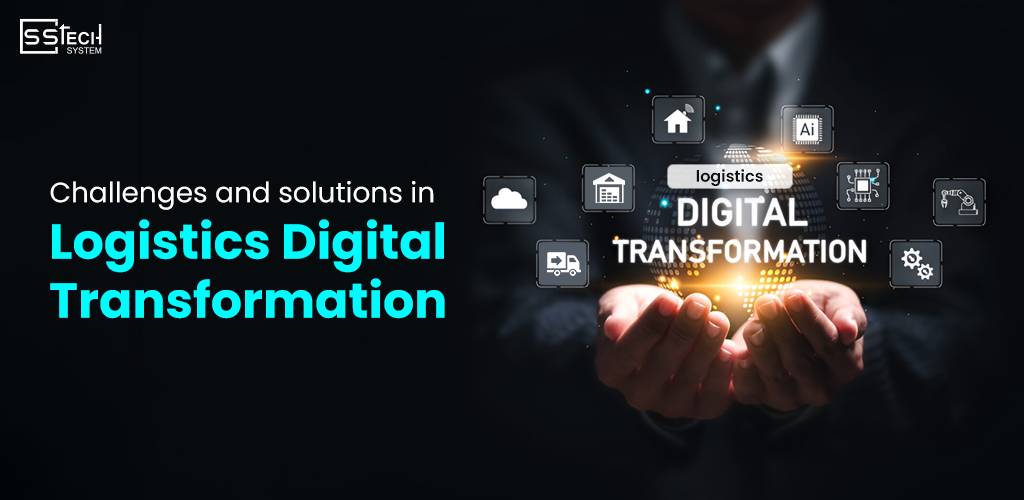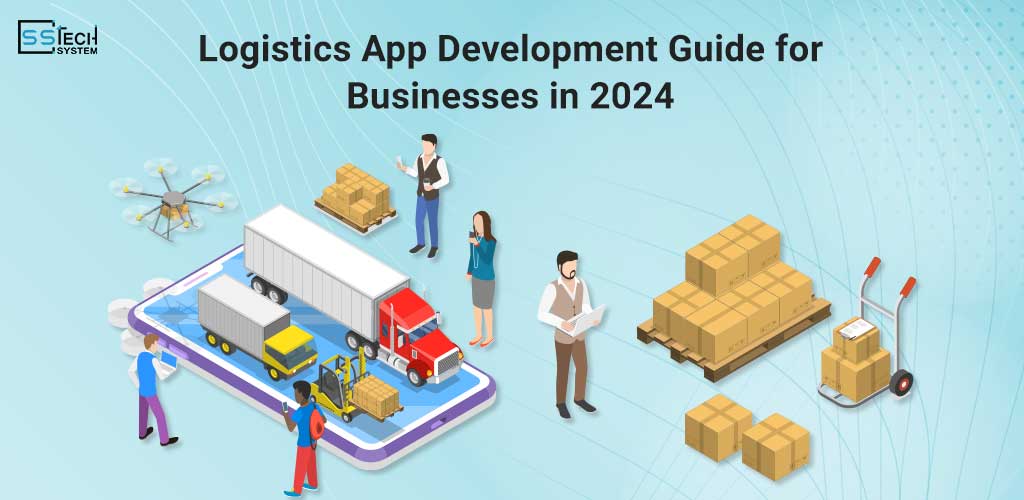
The logistics and transportation sector has undergone an avalanche of change in recent years. The accelerating change in customer demands, growing complexity of supply chains, globalisation (pandemics and geopolitical shocks), and mounting pressure on cost, speed, and sustainability drive organisations in this industry to no longer be able to afford the old business models.
The idea of digital transformation – the combination of digital technologies, data analytics, connection and adaptable operational patterns – has become central to the competitive, responsive and resilient logistics and transportation companies.
This article examines the changing landscape of logistics, analyzes the major challenges and their solutions (with real case studies), describes the implementation of digital transformation, demonstrates the benefits of this approach, provides examples of technologies in action.
The Changing Landscape of Logistics
The logistics and transportation sector, which was previously defined by rather inactive, linear processes of delivering something to point A to point B, is turning out to be a dynamic, interdependent ecosystem. There are a number of key trends that are changing the picture:
-
Globalisation and complexity of the network:
Supply chains have become longer, framed in a global manner, comprising several cross-border legs, third-party providers, multimodal transport, and various touchpoints. Such complexity requires increased visibility, coordination and flexibility.
-
Customer expectations:
End-consumers are now demanding quicker deliveries, transparency (real-time tracking), choice of delivery methods (same day, next day, click & collect), and perfect fulfilment. Logistics suppliers have to live up to these expectations.
-
Shock and stress on resilience:
Natural disasters, the labor gap, trade wars, and COVID-19 have been incidents that have revealed vulnerabilities in the supply chains. Therefore, the agility, real-time responsiveness, and resilience have become critical.
-
Sustainability pressure:
There is regulatory and societal pressure, which implies that logistics players should minimise emissions, optimise routes, use green modes and avoid waste. This is centrally based on digital tools.
Key Challenges and Solutions in Logistics Digital Transformation
In the path to digital transformation, logistics and transportation firms face many internal and external hurdles. Below are ten major challenge areas, along with solutions.
-
Legacy Systems and Infrastructure
Challenge: There are still a large number of logistics operators who are still using legacy systems (decades old, mainframes, spreadsheets, disconnected modules) that are inflexible, non-real-time, not standardised or scalable. These systems are obstacles to the adoption of more recent digital tools and inhibit change.
Solution: Create a new, modular IT system (where feasible, cloud-native), embrace middleware and micro-services, move data and progressively decommission legacy platforms and manage risk.
-
Lack of Real-Time Visibility
Challenge: The visibility all through the transport and supply-chain (inbound, in-transit, outbound, partner networks) is usually lacking. Firms find it difficult to react promptly to delays, disrupted or exception shipments when they lack real-time information about shipments, vehicles, inventory and partner whereabouts.
Solution: Implement IoT sensors (GPS, RFID), telematics, control towers (digital hubs of status monitoring), cloud dashboards, and exception-alert systems. Combine data on partners and show them in one picture to stakeholders.
-
Using Digital Tools for Sustainable Logistics
Challenge: Logistics processes must be put under more pressure to achieve reductions in carbon emissions, improve fuel efficiency, minimize waste, and promote green modes. Yet, many companies do not have the data, analytics, or digital solutions to track and manage sustainability indicators.
Solution: Routing-optimisation algorithms (cutting down on miles travelled), fuel-monitoring telematics, network design through digital twins, demand-responsive load planning, and monitor emissions through analytics platforms.
-
Supply Chain Complexity and Partner Integration
Challenge: The supply chains today have numerous levels: suppliers, carriers, 3PL/4PL providers, freight forwarders, warehouse operators, distributors, and retailers. It is difficult to integrate with all partners, to share data, coordinate the schedules, and synchronize the systems. Disintegration results in blindness and ineffectiveness.
Solution: Establish a partner-integration platform (API-based), establish a digital control-tower unifying all stakeholders, standardise data formats (EDI/API), offer shared dashboards, govern data flow.
-
Warehouse Automation and Robotics Integration
Challenge: Warehouses remain labour-intensive, manual processes. As e-commerce requirements and demands increase alongside an expectation of speedy fulfilment, companies must automate the picking, sorting, material handling, and data acquisition processes; however, many have difficulty designing and integrating robotics, automation, and warehouse management systems (WMS).
Solution: Invest in autonomous mobile robots (AGVs), robotics arms, sorting machines, vision systems, and integrate with WMS/WES (warehouse execution system), use digital twin simulation to create layouts, and streamline processes to be automation-ready.
Case Study: A large global logistics giant (client of HCL Technologies) implemented an automation ecosystem: multiple automation partners, AGVs, integrated 14 system interfaces via WMS to robotics hub. Results: 60% faster vendor onboarding, 25% reduction in warehouse errors, 50% lower operational costs.
-
Inventory Visibility and Demand Forecasting
Challenge: Poor inventory visibility (across warehouses, transport, retail locations) and inaccurate demand forecasts lead to over-stocking, stock-outs, excess costs and delayed fulfilment. Many logistics firms struggle to bring together data across operations, forecast demand, and synchronise inventory.
Solution: Deploy predictive analytics using historical and real-time data; extend visibility across all inventory nodes; adopt integrated inventory-management systems and dashboards; align demand forecasting with logistics capacity and warehouse/in-transit inventory.
-
Freight Management and Rate Volatility
Challenge: Freight rates are volatile (especially sea-freight, air-freight and road-haul), impacted by fuel costs, capacity constraints, geopolitical disruptions and pandemics. Logistics firms must manage freight bookings, contracts, spot rates, carrier performance, yet many rely on manual spreadsheets and lack predictive tools.
Solution: Introduce freight-management systems (FMS) with analytics, integrate dynamic routing and carrier selection, adopt digital marketplaces for capacity matching, use data to forecast freight rate trends, and integrate contracts with TMS (transport management system).
-
Driver Shortage and Workforce Management
Challenge: The logistics industry globally faces driver shortages, ageing workforce, high attrition, increasing regulatory and safety requirements, and pressure to upskill workers for new digital tools. Managing workforce scheduling, certifications, compliance, fatigue and changing job-profiles is increasingly complex.
Solution: Use workforce-management tools integrated with TMS/WMS; adopt digital driver-apps for dispatch, routing, e-POD (electronic proof of delivery); apply predictive analytics to anticipate attrition and scheduling issues; invest in training and digital adoption platforms to upskill workforce.
-
Capacity Planning and Load Optimization
Challenge: With fluctuating demand, multi-modal networks and shared asset utilisation, logistics firms must optimise capacity (vehicles, containers, trailers, warehouse space) and load planning – otherwise they may run under-utilised assets or inefficient flows.
Solution: Use advanced planning systems, load-optimisation algorithms (considering weight, volume, route, consolidation), digital twin simulation, and dynamic scheduling tools that optimise asset use across modalities and geographies.
Case Study: Nestlé’s Transportation & Logistics team, managing ~1,400 freight orders per week, automated its freight planning processes and improved load-utilisation significantly. They eliminated manual tasks by automating key steps—freight order creation, truck-loading plans, delivery scheduling and coordination—saving over 45,000 hours annually and cutting operational expenditure by around US $1.8 million.
-
Last-Mile Delivery Complexity
Challenge: Last-mile delivery is the most expensive and complex leg of logistics: traffic congestion, urban delivery constraints, same-day delivery demands, returns/reverse logistics, and customer experience all create complexity. Many logistics firms face inefficient routing, high costs, unpredictable delivery times and customer dissatisfaction.
Solution: Use route-optimisation tools, crowd-sourced delivery networks, micro-fulfilment centres, electric/alternative vehicle fleets, real-time tracking for customers, digital communication with drivers and customers, and integrate returns management.
Case study: SSTech, a logistics technology provider, implemented AI-driven route optimization and real-time delivery tracking for an e-commerce retailer struggling with delayed last-mile deliveries.
By integrating predictive analytics and IoT sensors, they reduced delivery times by 27% and improved customer satisfaction by 35%. Their solution also minimized fuel consumption and enhanced driver productivity. This transformation positioned SS Tech as a leader in smart last-mile logistics.
How to Implement Digital Transformation in Logistics
Implementing digital transformation in logistics is not a one-time project but a strategic journey. Here is a practical roadmap:
a. Identify digital gaps and set clear objectives
Begin by assessing your current state: systems, processes, data, culture, partner-ecosystem. Identify where you lack visibility, where manual processes dominate, what legacy constraints exist. Set clear goals: e.g., reduce order-cycle time by 20%, improve on-time delivery by 10 pts, reduce empty miles by 15%, improve customer satisfaction.
b. Build a roadmap and involve stakeholders
Stake out a roadmap of transformation (phased): pilot areas (e.g., real-time tracking), scale areas (warehouse automation), future-state (autonomous vehicles). Achieve the senior leadership, operations, IT, finance, partners and customers buy-in. Define governance structure, owners, KPIs and timeframes.
c. Integrate smart technologies
Depending on your roadmap, implement relevant digital capabilities IoT sensors and telematics to have visibility, cloud data platforms and analytics to get insights, robotics and automation in warehousing, digital twin simulations, freight/load-optimisation algorithms, workforce-apps and training, last-mile delivery platforms.
d. Train teams and foster a digital culture
Technology in itself does not bring value; people do. Invest in new systems, processes, and decision-making by upskilling your workforce. Leverage digital-adoption tools (in-app instructions, workflows, help) to enable user proficiency. Build a culture of constant improvement, teamwork, decision-making based on facts and innovation.
e. Monitor, measure, and scale
Measures such as on-time delivery, cost-per-ton km, empty-miles percentage, order-fulfilment cycle-time, carbon emissions, and error rates must be defined and monitored as key performance indicators (KPIs). Monitor progress through the use of dashboards and alerts and find areas of friction and improve.
Benefits of Digital Transformation in Logistics and Transportation
When successfully executed, digital transformation brings multiple benefits.
-
Enhanced Supply Chain Visibility
Using online tools, logistics service providers are able to see the whole chain, supplier-end-customer, in real-time. This visibility allows identifying a delay in good time, preemptive exception management, more efficient partnership and statistics. Visibility assists in transforming concealed blind-spots into intelligence actions.
-
Improved Transportation Efficiency
Online applications enable optimal optimisation of vehicle routes, enhanced utilisation of assets, reduced empty-miles, increased driver productivity and fleet management in real-time. These will lower the cost, consumption of fuel and delays in operations providing better margin and service levels.
-
Quick & Accurate Order Fulfilment
The warehousing automation (robots, AGVs, WMS integration), and better inventory planning and availability of real-time information make sure that orders are finished quicker, more precisely and with fewer mistakes. The resultant effect of this is increased customer satisfaction and reduced returns/corrections.
-
Better Resource Optimization
The digital tools facilitate a greater utilisation of all the logistics assets, including vehicles, trailers, containers, warehouses, and people. They facilitate load-optimisation, capacity planning, predictive maintenance (to minimize downtime), staffing of human resources, and demand-based resource allocation.
-
Improved Customer Experience
With a digital-enabled logistics ecosystem, customers will get real-time tracking, predictive ETAs, proactive communication, quicker fulfilment, and easier returns. These enhance brand differentiation, loyalty, and trust. Logistics companies that provide this will have a competitive edge in an era where Amazon is setting the pace of the modern world.
Examples of Digital Transformation in Logistics and Transportation
Below are examples of technologies and how major international companies have adopted them.
-
Predictive Analytics and Big Data
Companies now use big-data analytics to forecast demand, optimise inventory, predict maintenance needs and identify supply-chain risks. For example, some logistics firms use cloud data warehouses to unify operational datasets and perform live analytics.
DHL uses predictive analytics and big data to enhance logistics efficiency and anticipate delivery issues before they occur. By analyzing massive datasets from sensors, weather patterns, and customer behaviors, DHL optimizes routes, predicts parcel volumes, and reduces delivery delays.
Their “Resilience360” platform leverages predictive insights to assess supply chain risks globally, leading to smarter, data-driven logistics operations.
-
Telematics and Internet of Things (IoT)
Devices (GPS trackers, RFID, sensors) provide continuous data on vehicle location, cargo condition, temperature/humidity (for cold-chain), driver behaviour and equipment status. Large carriers and shippers deploy IoT for end-to-end visibility, asset tracking and proactive intervention.
-
Cloud-Based Computing
Moving from legacy on-premises IT to cloud platforms enables scalability, agility, integration, real-time access and cost efficiency. Many logistics firms now deploy cloud-native applications, micro-services, and managed analytics platforms.
For example, Deloitte provides transformation by using innovative applications of the cloud. Businesses on their way to the cloud can be served by their entire range of capabilities.
-
Last-Mile Delivery Technology
In the last-mile domain, firms use route-optimisation platforms, crowd sourced delivery, autonomous vehicles/drones (in some markets), mobile apps for drivers and customers, smart lockers and dynamic delivery scheduling.
-
Fleet Management Software
Transportation companies are deploying centralised fleet-management platforms that integrate telematics, driver apps, scheduling, maintenance, fuel-monitoring, load-matching and carrier performance dashboards.
For example, in Northern New Jersey, where Verizon has over 4,000 service vehicles, managers track down the precise positions of vehicles using Networkfleet and dispatch mechanics to retrieve the vehicles.
-
Mobility as a Service (MaaS)
Although more common in public-transit and mobility sectors, the concept of MaaS is extending into logistics: consolidating multiple mobility/transportation modes, providing dynamic asset utilisation, offering delivery-as-a-service platforms, and creating flexible delivery structures.
Uber Freight applies the MaaS model to logistics, digitally connecting shippers and carriers for real-time load booking and tracking. It offers transparent pricing, route optimization, and improved asset utilization. The platform has expanded globally, enhancing freight movement efficiency for thousands of carriers.
Conclusion
The logistics and transportation industry is at the cross road. The increasing demands of customers, worldwide turmoil, sustainability requirements and operational intricacy imply that digital transformation is not an option anymore it is a necessity.
Those firms which are open to digital technologies, modernised infrastructure, optimised visibility, automated operations, integrated partners, and invested in workforce will be the future winners.
Going forward, begin by discovering your digital gaps and business goals, create a realistic roadmap, adopt the appropriate technologies, enlist and inspire your people, and measure your progress. Remember: technology by itself doesn’t transform, the combination of people + process + technology does.
Frequently Asked Questions
Digital transformation in logistics refers to the process through which digital technologies are used to transform the operation of logistics and transportation fundamentally, including the IoT, cloud computing, AI, automation and analytics, and make them more connected, efficient, responsive and customer-centric.
Due to the industry being more complex, customers are demanding speed and transparency, sustainability goals and worldwide disruptions. Digital tools provide logistics companies with visibility, asset optimisation, costs reduction, better service and resiliency.
Among the main challenges are the existence of legacy systems/infrastructure, inability to gain real-time visibility, fragmented partner networks, workforce skill gaps, data silos, or resistance to change.
Begin by conducting digital gap assessment, establishing business-outcome goals, creating a roadmap, choosing technologies in line with the same objectives, involve people and partners, pilot initiatives, monitor KPIs and scale successful pilots.
The most active technologies are IoT sensors and telematics, cloud computing, big-data analytics, AI / machine-learning, warehouse robotics and automation, digital twins, fleet/transport management system, mobile / driver application and last-mile delivery platform.
Improved supply-chain visibility, better transportation efficiency, faster and more accurate fulfilment, enhanced resource and asset optimisation, higher customer satisfaction, and stronger resilience to disruptions.
The timeframe varies widely depending on scale, legacy state, geography, partner ecosystem and investment. Typically, firms may pilot a digital initiative in 6–12 months, scale more broadly in 1-3 years, but full transformation may span 3-5 years or more.
It is critical. Technology roll-out alone won’t succeed unless people adopt it, processes are redesign, and the culture supports data-driven decision-making, collaboration and continuous learning. Digital-adoption platforms, in-app guidance and training programmes help ensure success.










